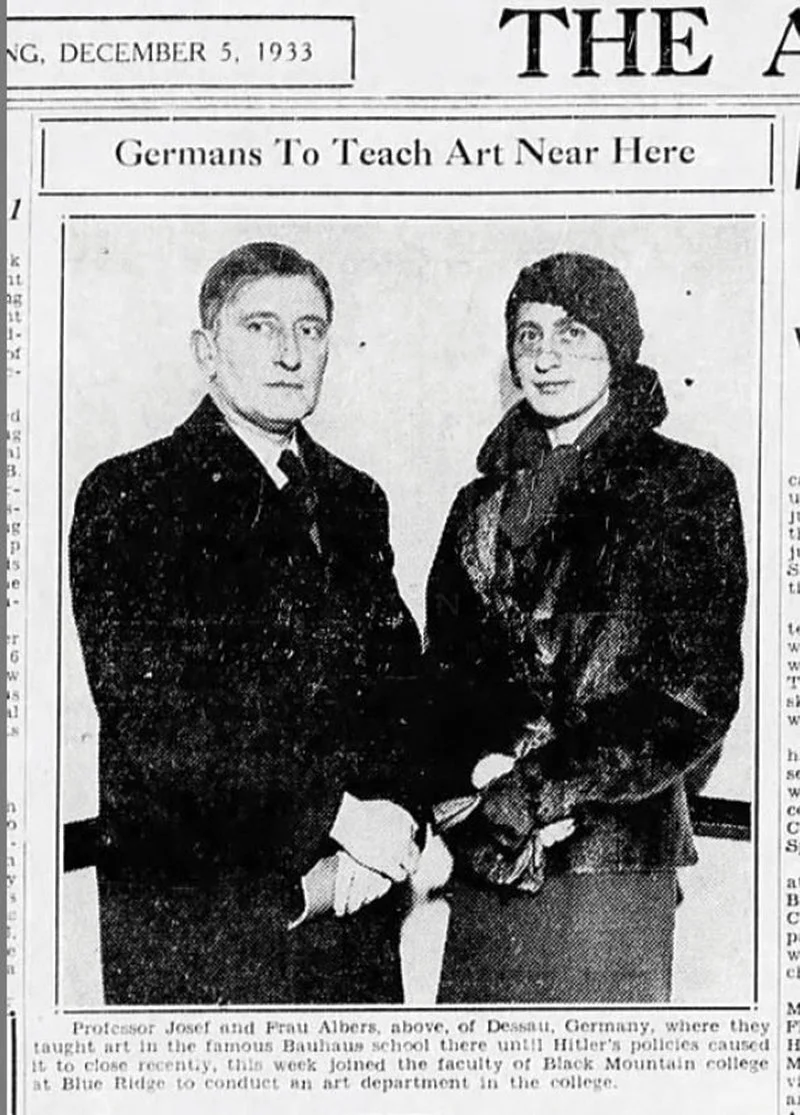The Story of Black Mountain College
From 1933 to 1957, a small experimental college in the mountains of North Carolina changed the course of American education and modern art.
In 1933, John Andrew Rice, a disgruntled college professor, was stirring up trouble at Rollins College in Winter Park, Florida. A staunch disciple of the philosopher John Dewey, Rice believed in breaking students free of the strict, hierarchical nature of assembly-line schools of the time and giving them control of their own learning. As the Great Depression swept across America, tensions boiled over. Rebellion was in the air.
Thousands of miles and an ocean away, as Adolf Hitler ascended to power, the Nazis set out to persecute artists and intellectuals all across Europe. The Führer was hell-bent on conforming Germany’s top art and design school—the Bauhaus—to his newly sanctioned rules. Josef Albers wouldn’t hear of it. Albers, one of the Bauhaus’s best-known artists and teachers, chose to close the school rather than obey the Third Reich.
Albers and his wife, Anni, who was Jewish, were desperate to flee Germany. Rice wanted to reform the American education system. They all needed a place where they could start anew. They would find it in the still mountains of North Carolina.
RICE WAS DISMISSED from Rollins soon after and joined the unemployed quarter of the U.S. population. Audacious and outspoken, he continued to criticize American higher education and formulated a plan to push the system’s boundaries by opening his own school.
His new college, he promised in a purpose statement he penned on onionskin, would “lead on to creative consciousness a carefully selected group of talented young men and young women who are eager to know, to will, and to do.”
Like the Bauhaus before it, Rice’s school would emphasize the connection between artists and design—between thinking and doing. The college would nurture the Deweyan ideals of independent thought, learning by doing, and arts at the core of education.
Theodore Dreier and Robert Wunsch, a North Carolina native, backed him. Wunsch suggested the school’s first location: a YMCA building in the rural Swannanoa Valley, the first of three locations the school would eventually inhabit. Despite advice that it was “the worst possible time for beginning a school,” in the midst of the Great Depression, Black Mountain College opened its doors in September 1933 with 26 students and 13 faculty members.
Josef and Anni Albers traveled by ocean liner. Leaving behind family and friends—and, perhaps worst of all, their beloved Bauhaus—they couldn’t point out North Carolina on a map when a startup in the mountains invited them to teach.
Josef was one of the Bauhaus’s best. The only student asked to join the faculty in the school’s history, Albers had led in the fields of painting, printmaking, and color theory for a decade. Anni, a force in her ow
n right, was known for her experimental use of textiles, helping to establish weaving as a viable element of fine and modern art. The Alberses were charged with making visual arts the center of the Black Mountain College curriculum.
The liberal arts college was unlike any other of its day, a close-knit social community whose members taught and learned in an atmosphere of experimentation and multidisciplinary influence. No board of directors charted the academic course; the curriculum centered on whatever faculty and students agreed upon.
In December 1933, The Asheville Citizen announced that Josef and Anni Albers would teach art nearby. Photo from Western Regional Archives, State Archives of North Carolina.
Everyone contributed to school operations—farmwork, kitchen duty, even construction: If a student believed a building would benefit his or her studies, he or she was encouraged to build it. Relationships flourished. Students existed with faculty on a level plane; some even forged romantic relationships. Cabbage patches doubled as photography classrooms.
“Students were in charge of their own education,” says Alice Sebrell, program manager at the Black Mountain College Museum in Asheville. “They placed the responsibility on the student … to succeed or fail on their own terms.” There were no published grades and no structured four-year tenure. Of the 1,200 students known to have been admitted over the years, estimates point to only 60 or so who graduated—with homemade diplomas in hand, no less.
Black Mountain College lasted only 24 years, but the school’s principles are still evident in progressive education models today. As the cost of education rises and the needs of the workforce shift, higher education is faced with creatively catering—through post-traditional tracks, student-faculty research projects, service projects, and apprenticeships—to the interests of the student. Black Mountain College’s influence lives on at present-day schools, including Bennington and Marlboro colleges in Vermont, Antioch College in Ohio, and Warren Wilson College in Swannanoa.
“(O)ur central and consistent effort is to teach method, not content; to emphasize process, not results … ,” Rice once told writer Louis Adamic. The school was a precursor to self-directed education. Fast-forward to today’s social landscape, and the guiding principles of Black Mountain College predicted an age in which content is available at the tap of a finger. How the content is used or why it exists, its faculty would teach, is more important than the content itself.
Read the full story at Charlotte magazine.




